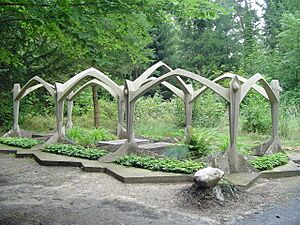Max Taut facts for kids
Max Taut (born May 15, 1884 – died February 26, 1967) was an important German architect. He was known for designing many buildings, especially in the 1920s and after World War II.
About Max Taut
Max Taut was born in Königsberg. He was the younger brother of another famous architect, Bruno Taut. Max, his brother, and Franz Hoffman started an architecture company called Taut & Hoffman in Berlin.
In the 1920s, Max Taut became well-known for designing office buildings for trade unions. These are groups that help workers. Between 1922 and 1925, he built one unique house each year on Hiddensee island.
Two of his most important buildings are the Deutscher Buchdrucker building (built from 1924 to 1926) in Berlin and the consumer cooperatives' department store (built from 1930 to 1933). These buildings are now protected as heritage sites in Berlin.
Max Taut was part of several groups of artists and architects who wanted to create new styles. These groups included the Glass Chain and the Novembergruppe. He was also a member of Zehnerring, an avant-garde architectural group. Other famous architects like Mies van der Rohe, Walter Gropius, and Erich Mendelsohn were also in this group. Max Taut was very important for developing buildings with visible frames. This style showed how the building was put together and represented a new, open way of designing.
After the Second World War, Max Taut and Wilhelm Büning started a new architecture school at the Berlin University of the Arts. Some of his buildings from after the war include the Reutersiedlung (built from 1948 to 1952) in Bonn and the Ludwig Georgs Gymnasium (built from 1951 to 1955) in Darmstadt.
Max Taut was buried at the Choriner monastery cemetery.
Max Taut's Buildings
Here are some of the buildings Max Taut designed:
- Janusz Korczak Gymnasium, which used to be the Knabenschule in Finsterwalde (1913)
- Administration building for the Allgemeiner Deutscher Gewerkschaftsbund in Berlin-Mitte (1922–1923)
- Two houses in the Weißenhofsiedlung in Stuttgart (1927)
- Verband der Deutschen Buchdrucker building on Dudenstraße 10, Berlin (1924–1926). He designed this with Franz Hoffmann.
- Alexander von Humboldt Oberschule in Berlin-Köpenick, which was once called Oberlyzeum "Dorotheenschule" (1929)
- Trade union building in Frankfurt am Main (1929–1931)
- Nöldnerplatz group of schools in Berlin-Lichtenberg (1927–1932)
- Reichsknappschafthaus on Breitenbachplatz in Berlin (1930). He designed this with Franz Hoffmann. It was built in the Bauhaus style with a steel frame and a ceramic-tile outside. Today, it is used by the Institute for Latin American Studies at the Free University of Berlin.
- Block of flats with a library on Dudenstraße 12–20, Berlin (1954–1955). He designed this with Franz Hoffmann.
- In 1963 and 1964, he helped renovate the Jagdschloss Glienicke, adding bay windows to the lower two floors.
- Ludwig Georgs Gymnasium in Darmstadt
Images for kids
See also
 In Spanish: Max Taut para niños
In Spanish: Max Taut para niños




